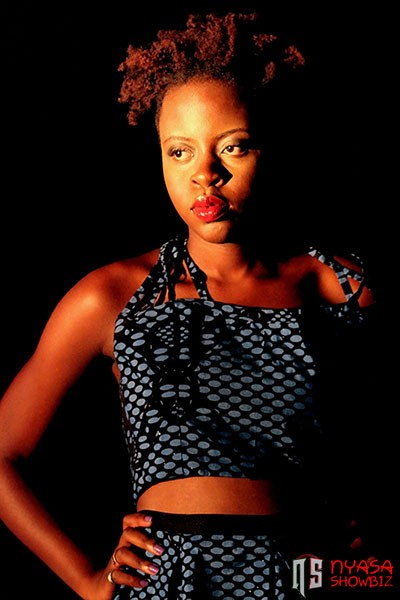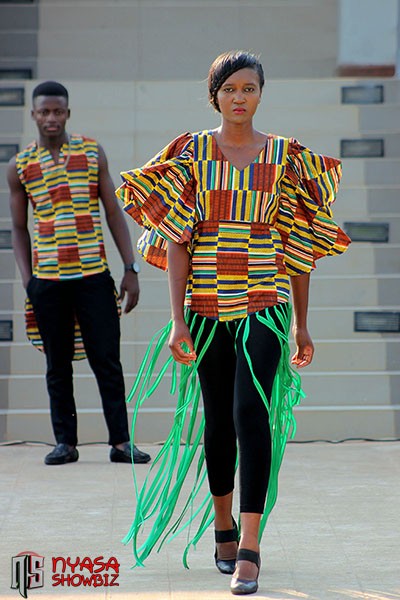Image may be NSFW.
Clik here to view.
Clik here to view.
 Model Sharon Kadangwe. Photo by Kimpho Loka.[/caption]
[caption id="attachment_100780" align="alignright" width="400"]Image may be NSFW.
Model Sharon Kadangwe. Photo by Kimpho Loka.[/caption]
[caption id="attachment_100780" align="alignright" width="400"]Image may be NSFW.Clik here to view.
 There are suggestions that government should intervene to protect models like these. Photo by Kimpho Loka.[/caption]
Models have been called prostitutes to begin with, and it has on several occasions been blamed for misleading the youth and disrespecting the country’s culture and traditions. I guess it’s safe to call it the black sheep of the industries.
However, in a bid to change the outlook the general public has on the industry in Malawi, 2015 saw dazzling and unique shows, including WAFE and HAEZ, which showcased Malawian designs, designers and models.
On top of that, the amazing videos released this year featuring Malawian models cannot be ignored.
These developments show just how much Malawians have grown in awareness and embracement of the industry. But is it safe to say the modeling industry is ready to take off on the international scene?
“Not yet. We still have a long way to go,” observes Samuel Sozela of Sparkling Photography in an interview with Nyasa Showbiz.
Sozela, who works with models on a regular basis, feels that the industry is not ready to take off internationally.
“I think there has to be modeling agencies and companies that will only focus on how to improve modeling in Malawi.
“Our models also need a lot of training. I’ve been to events where you’d clearly see that a model on stage had no idea what they were doing or what they were supposed to do.
“People forget that modeling is not just about walking on the stage but also knowing what to do next at a particular time,” he states.
Sharon Kadangwe, a model who has worked with big companies such as Airtel Malawi and Nedbank, as well as different designers among them Vanessa Nsona of DoroVee, Lillian Koreia of Miizu, Terrence Edwards of TMD and Lauretta of LV, suggests having a union for the industry.
“Malawi is very far from being taken seriously internationally. I think some Malawian models have what it takes to make it out there, but we don’t have an industry here to support us,” says the model.
“We are growing, but nothing tangible has been done yet. A union or committee would definitely be a way to start. There needs to be an independent body that sets the standard prices for all modeling work, which would be the foundation of some serious professionalism.
“Those who want to model professionally must register. Not everyone is a model. Pretty or unique looks don’t always mean you are the model-type,” adds the model who was also part of the Malawi Fashion Week 2013.
Capital FM’s Elita Soko observes: “The problem with modeling is the standards are set based on the western culture. There is a particular body type associated with modeling, which again is western.
“As long as we have a culture that we think we should adhere to, there is no way that the industry will grow to a point it can be taken to the international level, because we need to meet the standards which contradict with our beliefs as Malawians.”
There have been suggestions that government should be involved in coming up with policies for the industry.
“Government needs to be convinced that modeling is valuable enough, economically and socially. We need to prove its worth first,” says Soko.
Business and Entertainment journalist Earlene Chimoyo agrees that modeling has not flourished in Malawi because of cultural misconceptions and the public’s mindset about the industry and the players.
“To change the situation we need a multifaceted approach. As a country we must intensify awareness campaigns on women and girls empowerment in the social circles,” comments Chimoyo.
On policies, she says “It would be imperative to come up with guidelines that would promote use of local talent in the marketing of local and international products in the country. This would see the industry booming because then models, modeling agencies, and designers would find a ready market.
And this policy should also encompass issues of protection of rights of people in this industry. To this effect then I would say the government would need to play a role because such policies would have to be made national and properly gazetted.”
Are these ideas viable in 2016? Will the New Year see the growth of the industry? What other ideas do you think should be implemented? Please do share in the comments section.
There are suggestions that government should intervene to protect models like these. Photo by Kimpho Loka.[/caption]
Models have been called prostitutes to begin with, and it has on several occasions been blamed for misleading the youth and disrespecting the country’s culture and traditions. I guess it’s safe to call it the black sheep of the industries.
However, in a bid to change the outlook the general public has on the industry in Malawi, 2015 saw dazzling and unique shows, including WAFE and HAEZ, which showcased Malawian designs, designers and models.
On top of that, the amazing videos released this year featuring Malawian models cannot be ignored.
These developments show just how much Malawians have grown in awareness and embracement of the industry. But is it safe to say the modeling industry is ready to take off on the international scene?
“Not yet. We still have a long way to go,” observes Samuel Sozela of Sparkling Photography in an interview with Nyasa Showbiz.
Sozela, who works with models on a regular basis, feels that the industry is not ready to take off internationally.
“I think there has to be modeling agencies and companies that will only focus on how to improve modeling in Malawi.
“Our models also need a lot of training. I’ve been to events where you’d clearly see that a model on stage had no idea what they were doing or what they were supposed to do.
“People forget that modeling is not just about walking on the stage but also knowing what to do next at a particular time,” he states.
Sharon Kadangwe, a model who has worked with big companies such as Airtel Malawi and Nedbank, as well as different designers among them Vanessa Nsona of DoroVee, Lillian Koreia of Miizu, Terrence Edwards of TMD and Lauretta of LV, suggests having a union for the industry.
“Malawi is very far from being taken seriously internationally. I think some Malawian models have what it takes to make it out there, but we don’t have an industry here to support us,” says the model.
“We are growing, but nothing tangible has been done yet. A union or committee would definitely be a way to start. There needs to be an independent body that sets the standard prices for all modeling work, which would be the foundation of some serious professionalism.
“Those who want to model professionally must register. Not everyone is a model. Pretty or unique looks don’t always mean you are the model-type,” adds the model who was also part of the Malawi Fashion Week 2013.
Capital FM’s Elita Soko observes: “The problem with modeling is the standards are set based on the western culture. There is a particular body type associated with modeling, which again is western.
“As long as we have a culture that we think we should adhere to, there is no way that the industry will grow to a point it can be taken to the international level, because we need to meet the standards which contradict with our beliefs as Malawians.”
There have been suggestions that government should be involved in coming up with policies for the industry.
“Government needs to be convinced that modeling is valuable enough, economically and socially. We need to prove its worth first,” says Soko.
Business and Entertainment journalist Earlene Chimoyo agrees that modeling has not flourished in Malawi because of cultural misconceptions and the public’s mindset about the industry and the players.
“To change the situation we need a multifaceted approach. As a country we must intensify awareness campaigns on women and girls empowerment in the social circles,” comments Chimoyo.
On policies, she says “It would be imperative to come up with guidelines that would promote use of local talent in the marketing of local and international products in the country. This would see the industry booming because then models, modeling agencies, and designers would find a ready market.
And this policy should also encompass issues of protection of rights of people in this industry. To this effect then I would say the government would need to play a role because such policies would have to be made national and properly gazetted.”
Are these ideas viable in 2016? Will the New Year see the growth of the industry? What other ideas do you think should be implemented? Please do share in the comments section.
